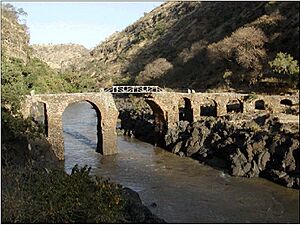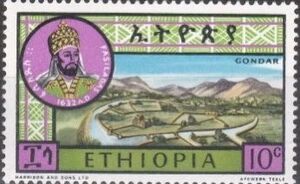Fasilides facts for kids
Quick facts for kids Fasilidesፋሲለደስ |
|||||||||
|---|---|---|---|---|---|---|---|---|---|
| Emperor | |||||||||

Mural showing Emperor Fasilides at Ura Kidane Mehret Church, Ethiopia
|
|||||||||
| Emperor of Ethiopia | |||||||||
| Reign | 1632 – 18 October 1667 | ||||||||
| Predecessor | Susenyos I | ||||||||
| Successor | Yohannes I | ||||||||
| Born | 20 November 1603 Bulga, Shewa, Ethiopian Empire |
||||||||
| Died | 18 October 1667 (aged 63) Azezo, Ethiopian Empire |
||||||||
| Issue | Four sons and one daughter, including Yohannes I and David | ||||||||
|
|||||||||
| Dynasty | House of Solomon | ||||||||
| Father | Susenyos I | ||||||||
| Mother | Sahle Work | ||||||||
| Religion | Ethiopian Orthodox Tewahedo | ||||||||
Fasilides (also known as Fasil or Basilide) was an important Emperor of Ethiopia. He ruled from 1632 until his death in 1667. He was a member of the Solomonic dynasty, a royal family that claimed to be descended from King Solomon. His special throne name was Alam Sagad.
Fasilides is famous for starting the city of Gondar, which became the capital of the Ethiopian Empire. This marked the beginning of a new time called the Gondarine period. He also made big changes by sending away the Jesuits (a group of Catholic missionaries) and forming alliances with nearby Islamic kingdoms to keep his country safe. He also led military actions against the Agaw rebels. In 1666, his son Dawit rebelled, and Fasilides had him put in prison at Wehni. The emperor died a year later and was buried in a monastery on Daga Island in Lake Tana.
Contents
Early Life and Rise to Power
Fasilides was born on November 20, 1603, in Magezez, Bulga, in the Shewa region of Ethiopia. He was from the Amhara people. His father was Emperor Susenyos I, and his mother was Empress Sahle Work. His grandfather was also named Fasilides.
In 1630, Fasilides was declared emperor during a rebellion. However, he didn't fully take the throne until his father, Emperor Susenyos I, stepped down in 1632.
Important Changes and Building Projects
Once Fasilides became emperor, he quickly brought back the traditional Ethiopian Orthodox Church as the official religion. He asked the leader of the church in Egypt, the patriarch of Alexandria, to send a new abuna (a high-ranking bishop). This helped to fix the old relationship between the churches that had weakened.
Fasilides also took back lands that belonged to the Jesuits and sent them away from his empire. When he heard that the Portuguese had attacked a city called Mombasa, Fasilides believed that a Catholic leader named Afonso Mendes was involved. Because of this, he banished the remaining Jesuits from Ethiopia. In 1665, he even ordered that the "Books of the Franks"—which were Catholic religious writings—be burned.

Fasilides is known for founding the city of Gondar in 1636. He made it the new capital of Ethiopia. He built many important structures there, including the start of the Fasil Ghebbi complex, which was his royal enclosure. He also built some of Gondar's famous 44 churches, such as Adababay Iyasus and Gemjabet Mariyam.
He is also credited with building seven stone bridges across Ethiopia. One famous example is the Sebara Dildiy bridge over the Blue Nile River. Because of his building efforts, many old bridges in Ethiopia are often thought to be his work.
Emperor Fasilides also built the Cathedral Church of St Mary of Zion in Axum. This church is now known as the "Old Cathedral" and stands next to a newer one built by Emperor Haile Selassie.
Challenges and Foreign Relations
A rebellion by the Agaw people in Lasta had started during his father's rule and continued into Fasilides' reign. He often sent armies to Lasta to deal with the rebels. One expedition in 1637 went badly, and the Agaw leader, Melka Kristos, even took Fasilides' palace for a short time. However, Fasilides quickly got help from other governors and defeated Melka Kristos. Another time, his army faced harsh conditions in the mountains, with many soldiers suffering from hunger and cold.
Diplomacy with Other Nations
Soon after becoming emperor, Fasilides stopped almost all contact between Ethiopia and Europe. He sent away all European Jesuits and their missionaries. Instead, he made agreements with nearby Islamic kingdoms to ensure safety. He also started diplomatic talks with powerful Islamic empires like the Safavids (in Persia), the Ottoman Empire (in Turkey), the Mughals (in India), and the Imams of Yemen. This period of Ethiopia being isolated from Europe lasted for more than 200 years.
Fasilides tried to create a new trade route in 1642-1647. This was because the Ottoman Empire controlled the port of Massawa. He chose a port called Beylul because it was outside Ottoman control and across from the port of Mocha in Yemen. He sent a message to the Imam of Yemen to get his support. The Yemenis sent an embassy to Gondar in 1646, but the project was eventually stopped.
He also sent a special messenger to India in 1664-1665 to congratulate Aurangzeb on becoming the ruler of the Mughal Empire. The messenger brought many valuable gifts, including slaves, ivory, horses, zebras, and fancy silver pistols.
In 1666, after his son Dawit rebelled, Fasilides had him imprisoned at Wehni. This brought back an old tradition of keeping troublesome members of the royal family confined on a mountaintop, similar to how they were once held at Amba Geshen.
Death and Burial
Fasilides died on October 18, 1667, in Azezo, which is about 5 kilometers south of Gondar. His body was buried at St. Stephen's monastery, located on Daga Island in Lake Tana. When an explorer named Nathaniel T. Kenney saw Fasilides' remains, he noticed a smaller mummy in the same coffin. A monk told Kenney that it was Fasilides' seven-year-old son, Isur, who had died in a crowd while trying to see the new king.
Family
Fasilides had three sons and three daughters.
- Yohannes I was his oldest son and became the next emperor.
- His other two sons, Dawit and Isuor, died before Fasilides.
- Theoclea was his oldest daughter. She married Laeka Krestos, who worked for her father.
- Kedeste Krestos was his second daughter. She married and had children.
- Sabla Wangel was his third daughter. Emperor Tewodros I, who ruled almost two centuries later, claimed to be related to Fasilides through her family line.
Images for kids
See also
 In Spanish: Fasilides para niños
In Spanish: Fasilides para niños





